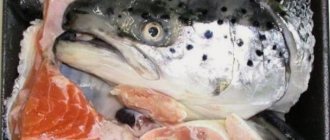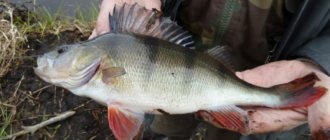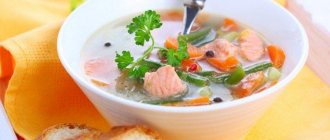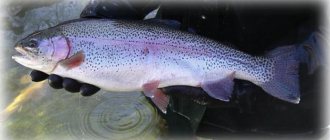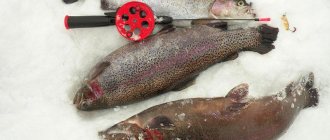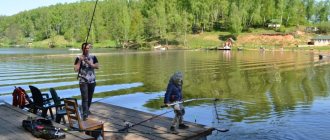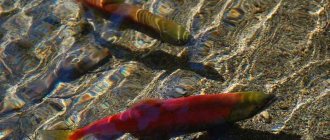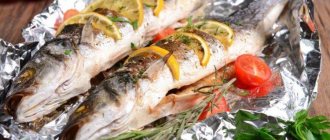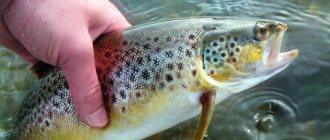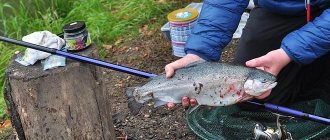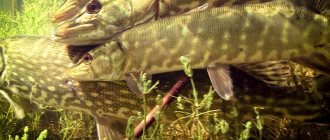Live food for trout
Live food feeding is very popular.
It has many benefits for trout. This is a natural way of feeding fish and increases its vitality. Providing a balanced and filling diet is very important. The range of live food is quite large, but choosing the right food is not always easy
For example, red mosquito larvae are often used for this purpose. They have a characteristic red color, which is due to the oxygen content. Fish love this food, and thanks to its red color they immediately notice it. The larvae can be stored in a cool place for one to two weeks.
Types of fish
Trout is a species of predatory freshwater fish that belongs to the salmon family. In the reservoirs of Russia you can find rainbow, lake and brook trout. And the last two species of this predator live in the Republic of Karelia. Lake trout, or brown trout (the name comes from the Sami word kuu︢dz︣a through the Finnish kums) are distinguished by their yellowish-brownish mottled color and shimmering scales. The stream, or “pied”, is distinguished by a brownish color with numerous dark and red markings on the body. This coloring is associated with the fish living in fairly dark water.
When do trout spawn?
Trout reaches sexual maturity, at which time it is ready to go to the spawning grounds, in the third year of life. Some species of trout reach sexual maturity at 2 years, and some at 5-6 years. But ordinary brook trout are ready to spawn at the age of 3 years.
Spring is considered the optimal time for reproduction not only in fish, but also in many species of animals and even in humans. Nature begins to come to life and makes all living things think that it is time to leave offspring. But trout does not fit into the overall picture a little. Trout spawning begins when everyone has long forgotten about the spawning of other fish. Its usual spawning time is late autumn and even winter.
Trout spawning usually begins in October-November. This date may shift depending on many factors, such as the type of trout, water temperature and the climatic zone in which spawning will take place. The further north the region, the earlier the trout begin to spawn.
Typically, the earliest trout spawning period is September, the latest is December. But there are species of trout that can spawn all year round, like crucian carp. But still, the bulk of trout spawns precisely in these few months - October and November.
When the trout reaches the spawning grounds, active spawning begins. The most active spawning hours are in the evening, after sunset and before midnight. Then, the trout goes to rest and returns to spawning in the morning at dawn. But in the morning, trout spawn not as actively as in the evenings, so to speak, in a lighter mode.
Trout spawning can last more than a month. Each female spawns all her eggs in just a few rounds and this can take more than a week.
Conditions and characteristics of spawning in trout
Trout reaches sexual maturity at the age of three years, then it goes to the place where eggs are laid. Age may vary depending on the subspecies of the family and living conditions. Some species are capable of spawning at the age of two years, but there are also those that mature only at 5-6 years of age. The common brook trout begins to spawn at the age of three.
At the age of three years, trout reaches a sexually mature state.Features of spawning in trout:
- fish tend to travel enormous distances to reach the place where they spawn annually;
- The spawning period for ordinary fish usually begins in spring or early summer, when the greenery begins to grow wildly. In warm conditions, it is easier for fry to survive and find food, but trout behave differently. Trout spawning time occurs in the second half of autumn. Sometimes trout prefer the winter season for spawning, but not later than December;
- the beginning and timing of trout spawning directly depend on climatic conditions in the region. In cold conditions, fish begin to spawn somewhat earlier, and in relatively warm regions - later;
- the earliest time of spawning is September, later – December;
- Certain breeds of fish tend to spawn all year, and therefore become extremely unpredictable. The largest number of species still go to spawn in October or November.
After reaching the desired breeding site, the trout begins to actively throw the game in large numbers. It preferentially lays eggs in the early morning or after sunset, when the sun has already set below the horizon. In the morning the activity is not too high, but in the dark, especially before midnight, trout tend to actively lay eggs. Females lay eggs in 2-4 approaches, leaving time for rest between them. To determine the period of spawning individuals, after arriving at the spawning ground, the fish are given at least 1 week.
Now trout fishing is strictly prohibited. For many fishermen, the pressing question of what to catch trout with is temporarily removed from the agenda until the fish return to their landing sites.
The second half of autumn is the time for trout spawning
What kind of trout should I breed?
There are about 20 species of trout. But you can grow a smaller part of them at home. Keeping trout is difficult because it is a predatory type of fish. Therefore, before breeding it at home, you need to make sure that you have enough finances for feeding.
Each type of trout has its own preferences for keeping. It is necessary to decide in advance which of them will be bred in order to organize suitable conditions.
Rainbow
Rainbow trout are native to North America. It is accustomed to cold temperatures, but grows better in warm conditions. It is recommended to keep rainbow trout at temperatures between 16 and 18 degrees Celsius above zero. This type has a number of advantages:
- fry weigh no more than 30 grams, making them easier to keep at a young age;
- in just a year, fish can grow up to 125 grams;
- young females can bring up to 800 eggs.
The disadvantage of rainbow trout is that sexual maturity in representatives of this species occurs at the age of about three years. For this reason, in the first years it is impossible to breed trout.
Males can be identified by their wide iridescent stripes. It appears during puberty. For trout farming, it is recommended to keep females until they become adults. At this age they are able to produce up to 3 thousand eggs. The birth of fry occurs in the spring.
Ruchevaya
Brown trout grow slower than rainbow trout and produce fewer offspring. In the first year, young fish reach a weight of only 25 grams. For a trout to weigh 500 grams, it must be at least 3 years old.
Benefits of brook trout include:
- adult fish reaches a weight of 12 kilograms;
- the female is capable of producing up to 1500 eggs;
- The diameter of one egg is only 7 millimeters, so storing them does not require much space.
Sexual maturity in brook trout occurs at the age of 3 years. By increasing the temperature to +8 degrees Celsius, the incubation period can be reduced to 65 days. If the eggs are stored in water at a temperature of +2 degrees Celsius, the incubation period will take about two hundred days. Young fish are born in autumn.
How long has it been since you had a really BIG CATCH?
When was the last time you caught dozens of HUGE pike/carp/bream?
We always want to get results from fishing - to catch not three perch, but ten kilogram pikes - what a catch! Each of us dreams of this, but not everyone can do it.
A good catch can be achieved (and we know this) thanks to good bait.
It can be prepared at home or bought in fishing stores. But stores are expensive, and to prepare bait at home, you need to spend a lot of time, and, to be fair, homemade bait does not always work well.
You know that disappointment when you buy bait or prepare it at home and only catch three or four bass?
So maybe it’s time to use a truly working product, the effectiveness of which has been proven both scientifically and in practice on the rivers and ponds of Russia?
Of course, it is better to try once than to hear a thousand times. Moreover, now is the season!
Find out more about the bait!
Spawning grounds
When it's time to reproduce, the pike perch looks for a suitable place to build a nest. Groups of predators leave deep waters, rushing to coastal shallows. These can be river oxbows, bays, eriks, small channels. Even marine and lake inhabitants enter river waters to spawn.
Photo 1. A shallow bay is one of the spawning areas.
The fanged predator makes its nests in areas of the reservoir with an abundance of grass, snags and other debris. Before the mating season, flocks break up into small groups consisting of one female and 2-3 males. Pike perch spawn in special nests, which females begin to prepare in advance. To build a cradle, the fish actively uses its pelvic fins. In this way, it is possible to remove remnants of grass and debris from the bottom, forming a clean area. The males join the female, leveling the ground with their bows. By joint efforts, a space is created with a recess of 5 to 10 cm, shaped like an oval up to 60 cm long. The nest is surrounded by branches and roots, which will protect the masonry from lovers of easy money.
In some regions where the walleye population is endangered, people are trying to help the fish spawn safely. The problem with the reproduction of this predator often lies in the fact that sexually mature individuals do not find a place to lay eggs. As a result of spontaneous spawning, the entire clutch dies. Therefore, caring ichthyologists proposed making artificial spawning grounds.
To organize them, first the reservoirs are cleared of remnants of vegetation so that the fish do not deposit sexual products on them. And then they make nests from stainless steel or vine branches. A special substrate is placed in the formed frame. It consists of nylon ropes and plant roots. To mark artificial spawning grounds, floats on thin cords are attached to the nests. Such spawning grounds do not cause fear or criticism among fish. In them, the caviar safely turns into fry, increasing the number of this predator.
Habitats
Rainbow trout prefer exceptionally clean water. Found in rivers with moderate currents and rocky bottoms. It can also be found in mid- and deep-water lakes, shallows and gravel bottoms of tributaries.
Despite its widespread distribution in Russia today, North America is considered the birthplace of rainbow trout. Later, the fish spread to other countries thanks mainly to artificial stocking. The main purpose was to grow it for sport fishing. The size of the fish, habits and methods of catching it turned out to be very convenient for fishing competitions. Recently, trout have been increasingly bred in commercial fisheries for commercial purposes.
On a note! Ichthyologists conducting experiments encountered an interesting fact. It turned out that rainbow trout taken from artificial reservoirs cannot exist in natural conditions. Fry released into rivers either go to sea, turning into common trout, or become stream pieds, taking root only in mountain streams.
Life cycle of brown trout
The life cycle of brown trout lasts about 20 years, their anadromous counterparts are slightly shorter, 17-19 years. They go out to spawn on average 9-10 times during their life. Females are fertile, but the number of eggs laid depends on age and reservoir, and therefore varies from 3 to 25,000. The size of the eggs is large and reaches 6 mm. The female throws them under a stone or into a nest, which she makes in advance with her tail.
A characteristic feature of brown trout is that the breeding season does not affect its appetite. She continues to forage intensively.
Several males can follow one female, but the one with more mature milk becomes a contender for paternity.
In the seventh or eighth week, the eggs hatch into fry. For four or five years, the juveniles stay in the river, grow and gain strength. It feeds on insect larvae and crustaceans. Then some roll into the sea, while others remain in freshwater bodies.
Individuals reach sexual maturity by three years, but already fully ripened milk is found in two-year-old males.
The population size is influenced by natural causes:
- 95% of the eggs released by the female are eaten by pike, grayling and their own eggs that have not reached sexual maturity;
- in subsequent years of life, the number of remaining individuals decreases by more than half.
The numerical composition of brown trout is decreasing not only as a result of natural selection, but also as a result of fishing, especially commercial fishing.
Choosing bait for brown trout
There are not many trophy winners in the ranks of our brother, so let’s land and look at “fish K” from the point of view of a professional spinner. The use of the adjective “professional” in the context of any sentence sounds somewhat bragging, but here this word will come in handy. And that's why.
Let me make a reservation right away - trolling is not considered in this material and is equated to fishing with a net, dynamite, spear, bleach and other methods that run counter to the philosophy of modern spinning.
By the time the author of the material was puzzled by fish K, he already had experience working with brook trout and grayling, so no problems were seen in this event. But in vain. Over the course of 4 seasons, two weeks each, I couldn’t even hold on to this fish.
Although, catching only brown trout was not the goal. It’s just that in promising places there has always been an emphasis in this direction. For example, the bait was changed, a dozen more casts were made, and so on.
“Excellent,” I thought as I approached the foam-white threshold, “a so-so place to catch pike.” Indeed, at first glance, fishing in a roaring stream seems impossible, if only because the fish simply cannot survive in this terrible whirlpool.
So, let's break stereotype number one. The choppy waters are full of fish. We see a surface turbulent current, but the fish are below, behind the rocks, on the border of the streams. The water is saturated with oxygen, the streams carry food, carry away weakened fry, which is still necessary for the fish. And it’s easier for salmon to hide from pike here.
As for Olanga, almost all local species are caught from the stream, with the exception of whitefish and ide, but pike, perch, grayling, brook trout and brown trout quite well bite on spoons in the stream.
When determining the type of bait for such fishing, do not reinvent the wheel. The most effective under these conditions is the good old shaker. To be specific, for the Park it is worth assembling a working set of four scales - 15, 20, 25 and 30 g.
During the history of communication with Olanga, I tested a huge number of spinners of various configurations, but in the end, the choice settled on the one that flies far, holds the stream and attracts fish. Yes, you guessed it, this is the well-known and accessible old Kastmeister.
If you hesitate when choosing a shaker, choose Kastmeister. By the way, about Chinese and other replicas of classics. Don't look for this ax under the bench - it's not there. In order to save money, many copies were tested, up to “from Uncle Vasya from the motor”, but this was not it. The jet is demanding in terms of form and content. Especially if you consider the manner of presentation of the bait in these conditions.
Features of trout fishing
Regardless of the conditions in which you have to catch trout, you must have certain skills. To catch this beautiful fish, you will have to demonstrate all your skill and skill.
In addition, it will not be amiss to familiarize yourself with the nature of the reservoir, learn about its features and the location of promising places. But the most important thing is the availability of suitable gear and catchable baits. If all the nuances are taken into account, then you can always count on catching this amazing fish.
Brook trout fishing
Brook trout fishing is more actively practiced by anglers, since fishing is carried out in natural conditions. When fishing, you should remember that this type of trout is quite shy and cautious. If you consider that the river where the trout lives is fairly clear water, then it can easily notice the silhouette of a fisherman. In order not to frighten the fish once again, it is better to move along the river in the direction of the current. What makes fishing interesting is that it is quite difficult to catch brook trout. In addition, you have to move along the river, the banks of which are overgrown with vegetation, and this is another serious obstacle.
Rainbow trout fishing
Rainbow trout are not particularly shy like brook trout, so they are not as difficult to catch. It is especially not difficult to catch it on a paid reservoir, where it is mainly caught. To catch it, it is better to select brightly colored baits. As a rule, trout bite well on red or yellow wobblers or flies. No less catchy are rotating spoons with bright petals, as well as widely used silicone baits that imitate the movements of various insects.
Lake trout fishing
Lake trout are characterized by a constant habitat. This type of trout becomes attached to the place where there is a sufficient amount of food. She can live here throughout her life.
Anglers are aware of this fact and with great pleasure go to the lakes with the hope of catching lake trout, which, in terms of taste, is not much different from other types of trout.
Lake trout are being actively caught on flies. The main thing is to determine which fly is currently catching fish. As many anglers testify, the ideal option is to fish with a larvae or dry fly in clear or flowing water. If the water is still, then you should give preference to a wet fly.
Lake trout lives in many water bodies in Russia. At the same time, you should always remember that trout can only be active in clear, clean water. When fishing in still water, it is better to use a wet fly.
When fishing in summer, it is better to look for trout in the depths, where they escape the summer heat
It is very important to know the moments when the fish are feeding, then the catch is guaranteed
How to catch river trout
River trout prefer fast water. Such areas are characterized by cool and clear water, with a rapid current. In addition, such areas should have a rocky bottom or flooded trees.
What does trout look like?
Depending on the species and habitat, trout looks different and there are many differences. But there are also general similarities in the description of trout. Typically, the body of trout fish is dense and voluminous, the nose looks as if it is blunt, but in large males, with a more elongated snout and a brighter body color, a small cartilaginous hook grows at the tip of the lower jaw. The paired fins of trout are rounded, the scales always have a round shape.
The trout's back is mostly brown or brownish-green, the sides of the fish's body are light, silver, yellow or yellowish, and the fins are yellowish-gray. Red spots on the body of a trout are usually located along the lateral line or on its sides and may have a blue border. It happens that the trout looks without obvious spots on the body, there are no red and no black spots, but only small specks remain. The dorsal fin of the fish is usually dotted with black and red spots. There is an adipose fin on the back between the dorsal and caudal fins.
The color of trout varies depending on its habitat, the color of the water and environment, the food and the time of year. Obviously, in calcareous water, the body of a trout always looks lighter and silverier, and in rivers flowing along a peaty or muddy bottom, trout are very dark in color.
Male trout differ from females in the relative size of their heads and the larger number of teeth; in some older males, the tip of the lower jaw curves upward, like a salmon. And like many fish, female trout are always comparatively larger than males.
The size of trout depends on its habitat and species; usually it does not reach the size of salmon and taimen. River or brook trout in rivers and streams reaches a size of no more than 20-40 cm. Lake and sea trout reach significant sizes, and under very favorable conditions grow up to one meter long and weigh up to 12 kg. The size of a trout depends on the abundance of food in a given water area, and with an abundance of food, trout grows very quickly.
Trout Spawning
Trout spawning time is from September to November. Spawning sites are fast rocky and pebble-sand rifts, as well as areas above rapids. Having spawned, brown trout either go to sea that same fall or remain in the river until spring. The percentage of death after spawning is insignificant.
Young trout spend 3 to 6 years in the river, after which they slide into the sea.
Trout feed both in the sea and in the river on crustaceans, insects and small fish.
Lake trout is found in Lakes Ladoga and Onega, as well as in many cold-water lakes in Karelia and the Kola Peninsula. Special subspecies live in high-mountain lakes (for example, in Sevan in the Caucasus).
In addition to some subspecies, trout is an anadromous fish, that is, it constantly lives in the lake and spawns in streams and rivers flowing into it.
It enters rivers for spawning in the fourth to sixth year of life. In most rivers it rises in spring and summer and spawns in the same year. In addition, in the rivers Vuokse and Svir, an autumn movement is observed in September-November. Trout that rise in the fall are called the “winter” form and spawn the following year. Spawning occurs in fast rapids sections of the river from late September to November. After spawning, the fish does not die.
Lake trout that hatch from eggs live in the river for 3 to 5 years. In the lake they grow up to 2.5–3 kg,
occasionally up to 10
kg.
Having risen to the river to breed, they sometimes feed during the entire period of their stay in the river, and sometimes (in particular, in Vuoksa) only after spawning.
In the lake, trout feed mainly on small fish, mainly those living in the upper layers of water and away from the shore (for example, vendace, smelt, juvenile whitefish). In summer, the trout's main food consists of insects, which it catches on the surface of the water.
Brook trout (pied trout) inhabits many fast and cold-water rivers in the European part of the USSR. It is common in the Karelian Autonomous Soviet Socialist Republic, on the Kola Peninsula, and in the Baltic Sea basin. There are in the Caucasus and Crimea. Usually found in those reservoirs where sea or lake trout could get into. It is believed that brook trout are lake or sea trout that have degenerated over many generations spent in the river.
It differs in appearance and color from other trout. Characteristic are red or orange spots surrounded by a light rim.
The usual weight is 300–500 g, occasionally specimens weighing 1–2 kg are found.
In summer, the medium-sized moth stays in small groups on the rapids of the river, choosing quiet areas. Large moth prefers deeper places near shelters, such as a tree fallen into the water, large stones, bridge abutments, etc. It likes to stand on dumps - the transition of shallows into depth, near steep banks into which a stream of water hits, and on the border of fast and slow currents. In spring and autumn, it does not go far from its favorite sites, choosing deeper and quieter places nearby.
He spends most of his life settled. It makes small movements only in search of convenient spawning areas and sometimes during floods, rising upstream in both cases.
Spawning, even in the same river, is extended and lasts from October to February, at water temperatures from 0 to 6°. Spawning sites are shallow and fast riffles.
It feeds throughout the year, except for the spawning period, the hottest days in mid-summer and moments of sudden turbidity of the water. The food is small crustaceans, insect larvae, insects, fish eggs, and for large damselflies, sometimes small fish, mainly minnows. In summer it fattens mainly in the morning and evening. In the north it also feeds on white nights. In spring and autumn, as well as in cold cloudy weather, it feeds almost all day.
Stages of Spawning
When trout spawning begins and the fish finds a suitable place to lay eggs, the first thing it does is prepare a nest. The fish works tirelessly with its fins and works with all parts of its body. When the place is ready, she lays eggs in the formed hole, then the male swims up and fertilizes.
Life cycle of the salmon family
Female trout are very picky in their choice of males, and choose mature and strong ones, and they try not to allow very young individuals to reach the eggs. This is explained by the fact that fish care about the quality and health of their offspring.
Then the female tries to very quickly cover the nest with stones. Although the eggs stick well to any surface, this effect soon disappears, and future offspring can simply be washed away by the current. In addition, stones are needed for protection from predatory fish, which swim nearby in search of food during trout spawning.
Despite all the efforts of the mother, most of the fry do not have time to be born after spawning. Not all of the born individuals will be able to get to the right places, meeting predators along the way and encountering other difficulties.
Appearance of fry
Trout fry
During trout spawning, females release about 500–2000 thousand eggs, which are similar in size to a pea of allspice. Such eggs will turn into fry only after 2–3 months; the size of the babies will be about two cm. The initial food for them will be the yolk sac. This is an embryonic organ with a sufficient supply of yolk, which remains with them after birth.
Pouch feeding occurs for quite a long time, approximately 3–5 weeks. All this time the fry sit in a shelter between the stones and do not risk showing themselves outside. The independent search for food begins only when the kids are already stronger and have gained strength. During this period, plankton is added to their diet.
Growing up period
Grown-up individuals that managed to survive begin their journey downstream, since there they can find a sufficient amount of food for feeding. Usually, after plankton, the first food for the fry are careless insects that end up in the water. The next stage is where mayfly fishing begins. This winged insect is the favorite food of trout.
In autumn, trout fish grow up to 9 centimeters
In the fall, the fish will grow up to 9 centimeters, and after 2 years they will turn into full-fledged individuals, 20 cm long. If an adult trout is pursued by a predator, it can jump 2 meters out of the water. At the moment of the jump, its speed reaches up to 30 km/h.
But positive developments can only be expected if there is a sufficient food supply; if the fry are unable to get to places with plenty of food, they will simply die.
Sometimes fry are born with deviations in which normal development is impossible. Fish can be born hermaphrodites or with more than one head, but defects in fins and color are most common.
Description of the fish
The rainbow trout fish is relatively small: the weight of an adult reaches 2 kg, the body length is no more than 1 m. A medium-sized specimen is 35 cm long and weighs about 500 g. If it lives in places where it has the opportunity to eat plentifully, its size increases significantly , and a well-fed “champion” can weigh up to 1.5 kg. The most outstanding, record specimen gained a body weight of more than 5 kg!
This fish is distinguished from other species by a noticeable detail: on the sides of the body it has a red stripe, shimmering in various shades from deep purple to bright orange and similar to a stripe. In spawning males, this stripe becomes pronounced: a beautiful mating plumage! It is because of the iridescent decoration that the fish received its scientific name - Salmo irideus.
The body of an adult specimen is dotted with small dark spots extending beyond the fins. And in the iris they are always dark, and not colored, like in brook trout.
The body shape of this trout is elongated, the tail fin has a pronounced notch. The body is flattened laterally. The muzzle looks short and truncated. Body color depends on the habitat: it is light where the bottom is light, and darker where it is dark.
Ichthyologists, having studied the life cycle and properties of the fish, concluded that its ancestor was one of the ancient species of Pacific salmon. Today it is classified as a freshwater form of the saltwater salmon Salmo gairdneri, also known as steelhead or steelhead.
Weight and size
Most often sold in carcasses weighing 1-2 kg, less often in portions of 300 gram fish. It makes no sense to grow it too large; its taste will deteriorate. In its natural environment, rainbow trout can weigh several kilograms, but such fish are less versatile in preparation.
Where does it live?
Rainbow Trout Habitat
Habitat: clean running water with a high oxygen content. In the natural environment it is found in Kamchatka and Alaska, as well as in South America. In artificial conditions in Russia it is bred in all regions. Sometimes mykiss are released into paid water bodies for fishermen.
What does it eat?
Rainbow trout is a predatory fish; it feeds on smaller fish and sometimes eats small crustaceans, insects and eggs of other fish. The taste of the finished fish will depend on the nutrition.
Lifestyle
This fish chooses exceptionally clean habitats: fresh, cold springs with a transparent rocky bottom. Once a reservoir becomes polluted, trout are the first to die of all the underwater fauna. It follows that trout meat is environmentally friendly, and therefore healthy.
After spawning, the fish move down to the river beds and stay closer to the bottom. It feeds on minnows (small fish).
In summer, when the water warms up by more than 15°, schools stay at the mouths of rivers and springs, since the water temperature there is much lower.
Individuals that have not reached half a kilo in weight are not predators and parasitize at the expense of their older relatives, feeding on their eggs. In addition, they feed on earthworms, which are washed out of the soil with rain.
Diet
This is a very voracious fish. Eats all year. The amount of food eaten per day corresponds to 2/3 of its weight
When catching fish, it is important to know what trout eat: plankton, fry, insects, and crustaceans are part of its diet. As fish age, their appetites increase: they hunt small fish or eat younger relatives.
Predators jump like flying fish above the water, which allows them to feast on winged insects. A lot of food gets into the water thanks to the wind. Grasshoppers, flies, and midges also form part of the fish’s diet.
Spawning process
Trout spawn when an individual reaches two years of age. They go to spawn in the fall, from permanent places where trout are found, and swim to shallow water areas. Eggs are laid in underwater depressions, which they build with their tail.
Spawning
Reproductive functions in brook trout appear in the 3rd year of life. It spawns once every two years at a water temperature of 5─7˚C; in the southernmost latitudes, spawning begins in the second ten days of November and continues for 35-40 days, in other areas 1-1.5 months earlier. To spawn, trout rise upstream, choosing shallow areas with weak currents and rocky soil on the rifts.
Its preference for rocky bottoms is no coincidence; it is explained by its unusual spawning method. The trout, with the help of its tail and paired fins, digs a hole in the soil into which it spawns. After the male fertilizes her, she covers the clutch with pebbles, thereby protecting the eggs, which quickly lose their stickiness, from being washed away and eaten by other fish.
Trout spawning, which at first glance seems to be a group spawning due to the large number of males surrounding the eggs, is actually a pair spawning.
Only one male takes part in the fertilization process, which, before the most crucial moment, drives away all the other contenders for the “main role.”
Despite all precautions, most of the eggs die, becoming prey for representatives of the same species and other fish that are constantly experiencing a feeling of hunger associated with a lack of food at this time. Making considerable efforts, hungry fish manage to look for and dig up trout nests, eat eggs, whose long development period ─ from 1.5 to 3 months contributes to such a sad scenario
Making considerable efforts, hungry fish manage to look for and dig up trout nests, eat eggs, whose long development period ─ from 1.5 to 3 months contributes to such a sad scenario.
The few offspring of brook trout, emerging from the surviving eggs, remain in the larval stage for a month, leading an almost motionless lifestyle, hiding under stones and other shelters.
All this time they feed on the mother's yolk, enclosed in a pouch on their tiny body. In the spring, the stronger fry slide downstream, settling in places with calm water that are convenient for self-feeding on small living organisms.
Growing cycle and technology
Growing trout takes quite a long time. In order for the fry to grow to the size of an adult fish within a few years, it is necessary to create suitable conditions. The equipment used for trout farming is also suitable for other types of fish. The difference lies in the unique conditions. To do this, it is recommended to first study the features of the natural environment in which the trout lives.
Suitable water chemistry for keeping trout includes the following standards:
- oxygen level - from 7 to 11 milligrams per liter (the necessary indicator will be provided by the aeration column);
- pH value – not lower than 6.5 and not higher than 8 (if it falls below the permissible norm, the fish stops reproducing; if it rises higher, the trout may die);
- nitrate concentration – up to 100 milligrams per liter (above this value poses a risk to fish);
- ammonia level - 0.1 milligrams per liter;
- hardness index – from 8 to 12;
- carbon dioxide content – up to 35 milligrams per liter;
- chlorine level – up to 0.01 milligrams per liter.
To check chemical indicators, special devices are used, which can be purchased at hardware stores.
Feeding fry and adult fish
Proper feeding determines how long it will take for the fry to grow to the size of an adult, and how tasty the fish will be. There are two types of trout food: organic and dry. Fish tastes better if the first type is used.
To give fish meat a red color, canthaxanthin should be added to the food.
Feeding of fry and adult fish is different. You should start feeding trout from the moment it is born. The diet for fry consists of:
- zooplankton (egg yolk may be added);
- meat and fish flour;
- fish oil.
You can prepare a mash by combining different feed options. The optimal number of feedings per day should not exceed 9 times. A thousand individuals require about 90 grams of food. There is a special floating and sinking type food available for sale that simplifies feeding.
Adults can be given dry and live food. The ratio of these species is divided approximately equally with a bias in favor of living species. The diet for adult fish consists of:
- chopped animal meat;
- fish waste;
- shrimp;
- water snails;
- insects
Fiber is also used to feed fish. It does not provide any benefit to the trout, but it loosens other types of food, making them better digestible.
Temperature
In a body of natural origin, it is difficult to regulate the temperature. Therefore, it is recommended to keep trout in a RAS. Depending on the age, the following indicators are suitable for this type of fish:
- from +6 to +12 degrees Celsius – for the ripening of caviar;
- from +10 to +14 degrees Celsius – for fry;
- from +14 to +16 degrees Celsius – for adult fish.
The temperature gradually rises as the trout grow.
Care and cultivation standards
In order for trout to develop well, you need to follow a number of tips. The water must have the right temperature and sufficient oxygen. It is necessary to check the serviceability of filters - water contamination can harm the fish.
It is recommended to separate small and large fish by placing them in separate containers. Thanks to this method, weak individuals will get more food and they will grow faster. During the spawning period, the best individuals should be selected to produce offspring.
With normal development, the weight of rainbow trout is:
- 30 grams – at the age of fry;
- 125 grams – one-year-old individuals;
- 200 grams – fish over two years old.
Brown trout develop more slowly, so the indicated indicators for it are lower at the same age.
Diet
Trout feed on other fish, and soft-bodied aquatic invertebrates such as flies, mayflies, caddis flies, stoneflies, clams and dragonflies. In lakes, various species of zooplankton often make up a significant portion of the diet.
Read: Making homemade lures for pike
Typically longer than 30 cm (12 in), trout prey almost exclusively on fish when possible. An adult trout can eat fish up to 1/3 of its length. Trout can feed on shrimp, grub larvae, bloodworms, insects, parts of small animals and eels. 1 trout fillet (79 g) contains: 117 kcal; 5.22 g fat; 0 g carbohydrates; 16.41 g protein; 0 g.
Trout and char from fish farms are sold as food fish. According to the British Nutrition Foundation, trout contains the least amount of dioxins (environmental pollutants) of any fatty fish.
Trout spawning All about trout
When do trout go to spawn?
The name trout combines many forms and subspecies of freshwater salmon of the genus Saimo. There are lake, river, stream and trout. The sea trout (trout) that lives in the coastal strip of the sea stands apart.
All trout spawn in pairs. Trout are fish with an autumn spawning period, the time of which depends on the water temperature and location of the reservoir. For trout of the Leningrad region, Karelia and Kola, spawning usually begins at the end of September. This wonderful fish is caught in the summer.
Brown trout
Unlike freshwater forms of trout, sea trout become sexually mature much later. Usually this beauty comes to its first spawning at the age of 6-8 years, less often earlier.
Brown trout begin their ascent to spawning grounds in May or June and last 2-3 weeks, but unlike salmon, they do not make long-distance migrations. In many rivers it continues to feed during its passage.
Adult females spawn, depending on age, from four to eight thousand eggs with a diameter of up to 5 mm.
Biological features
This species has an elongated, slightly laterally compressed oblong body.
The surface of the body is covered with dense small scales. Trout is a cold-water fish. The optimal environmental parameters are water temperature 14-20 °C and oxygen content 7-8 mg/l.
Interesting fact. Although it is generally accepted that trout like cold water, they also feel comfortable in relatively warm water. The point here is not so much the temperature itself, but rather the sufficient amount of oxygen dissolved in the water. Trout are found in cold, deep-water lakes, both at great depths and near the shore, where the water is warmed by the sun.
Under natural conditions, the fish reaches about half a meter in length and 1-1.5 kg in weight. However, in large lakes there are specimens one meter long and weighing more than 8 kg. In rare cases, the life expectancy of rainbow trout can reach 11-12 years. Most trout live only 6-8 years.
Varieties of coloring
The color of the body changes depending on the color of the bottom, the transparency of the water and the shade of the impurities it contains. Most often, the belly of the fish is silvery-white, and the back is greenish. There are numerous spots on the body and fins, with more of them above the lateral line, and closer to the abdomen they almost end.
The color of the fish may vary depending on habitat conditions, spawning and general condition. In general, the young individual has silvery sides, the back is always darker than the sides.
The inhabitants of small lakes are paler and have fewer black spots. They are more silvery and almost devoid of the distinctive reddish stripe inherent in river and stream forms of fish.
Spawning
The most aggressive males that have passed the selection follow the female and immediately water the eggs with milk.
The female fills the nests with fertilized eggs with fine gravel. Puberty occurs at 3-4 years of age. Spawning occurs in the spring from mid-April to the end of June, but some populations can spawn in the fall, and fish can spawn during the day and at night. Trout caviar ranges in color from orange to almost pink. The eggs are quite large, their diameter is 4-6 mm.
First, the female makes peculiar nests in the ground, which look like depressions among the stones. Then she lays a certain number of eggs in each nest. In one nest there can be approximately from 500 to 10,000 pieces.
The most aggressive males that have passed the selection follow the female and immediately water the eggs with milk. The female fills the nests with fertilized eggs with fine gravel. After approximately 5 weeks, the first larvae begin to hatch from the eggs. After a few more days, the fry begin to leave the nest.
Read How to breed worms for fishing at home
Nutrition
Rainbow trout is a voracious predator. Juveniles mainly feed on insects, and the menu of large individuals consists of fish (minnow, verkhovka, dace), frogs, small rodents and chicks of waterfowl.
The fish continue to feed, albeit with varying intensity, all year round. In summer, with the appearance of aerial insects, trout hunt mainly at the surface of the water. In winter, fish go to the depths, where their diet already consists mainly of bottom organisms, crustaceans, mollusks and insect larvae.
On a note! In trout farms, fish are accustomed to both natural and artificial feed. In such favorable conditions, it grows much faster and reaches large sizes.
At first, the fry stay and feed in schools, the number of which decreases as the fish grow older. Adults like to hunt alone, occupying certain areas of the reservoir and driving away other fish from there. When the food supply in the reservoir is scarce, the predator begins to migrate in search of a more suitable place.
